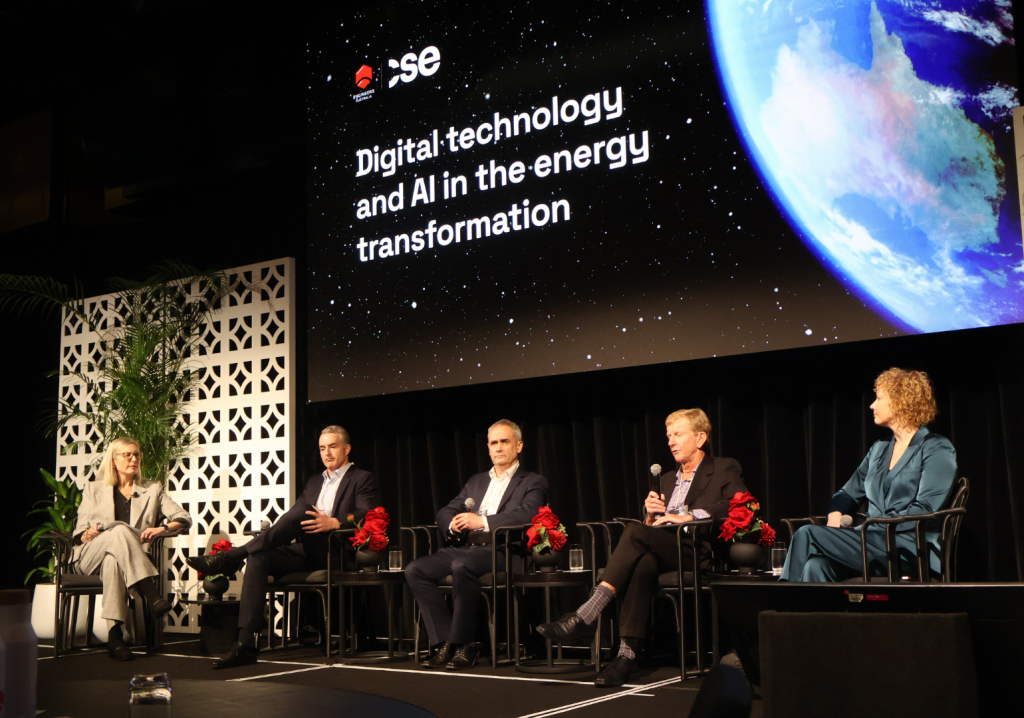With AI spurring a more than tenfold increase in energy demand from data centres, how can Australia ensure that a decarbonised network can cope?
Like much of the world, Australia’s data capacity has leapt ahead significantly in recent years.
“Ten years ago, the largest data centre in Australia was … 32 MW,” said Colette Munro MIEAust CPEng EngExec, Pacific Zone President at Schneider Electric.
Just last year, however, multiple 300 MW data centres were constructed, and a 500 MW centre is on the cards for 2025 – a significant increase in capacity and frequency.
What’s more, a ChatGPT search uses 10 times more energy than a Google search, according to Munro.
Not only does this indicate the immense power demands of ever-evolving technologies, it also means that the drastically increased carbon emissions need abating.
Clear vision required
Munro facilitated a discussion on the intersections between data, digitalisation and AI at Engineers Australia’s Climate Smart Engineering (CSE) 2024 conference in Brisbane, with the panel bringing together insights from academia, industry and state government.
“When we talk about AI, we quite often discuss … how it will improve in the future,” said Allys Todd, Co-Founder of ValAi, a digital services company focused on decarbonisation. “It’s important for us to … reframe that AI is already embedded in all of our systems in ways that [we] perhaps don’t realise.
“It’s important when we’re engaging with AI that we look at novel ways in which it can help us communicate messages across all of our audiences, so it actually encourages them to participate more.”
For Jack Curtis, Chief Commercial and Operations Officer at Neara, the lack of transparency in conversations about AI requires a set vision for how it can be implemented practically.
“In the energy transition, there are so many stakeholders that play a role – whether it’s the network, generators behind the metre, retailers or prosumers – and everyone has a role in contributing data and being a recipient of data,” he said. “The challenge right now is that there’s a massive opacity between all these many stakeholders in the energy transition system, and being able to take that veil off data opacity, and provide transparency.”
He recommended taking a new approach.
“If you don’t go into these conversations with [an] appreciation for what exactly you [are] changing – not just what the role AI does, but the role from a workforce … change management [and] workflow point of view – we’re going to be constraining its potential,” Curtis said.
“How do we make it fit for purpose for an industry like this, which is a very non-trivial, technical industry? We have to be more thoughtful going in.”

Data, data, data
Peter Price, Chief Engineer at Energy Queensland, said that although “everyone talks” about AI, it’s data that poses a significant challenge.
“We’re now moving those data systems to the cloud, we’re augmenting traditional network data, which tends to be static,” he said. “We’re trying to move that together to make asset management decisions, but also real-time operational decisions.
“I think we need to take a step back, as an industry, and really make sure we get that data hierarchy, those data structures and data strategy right … [it’s like] having to build a new plane while we’re flying it – that’s what we’re all doing with our data systems as well.”
For Professor John Fletcher, Director of the UNSW Digital Grid Futures Institute, the question of regulation and lagging standards is “not necessarily fit for purpose”.
“If we want to use AI in our network, there’s going to have to be some way of regulating it,” he said. “The challenge that I see is how do you actually understand whether an item of equipment has AI embedded in it in the first place?”
Read how data centres located underwater could be the future of efficient and environmentally friendly data storage and cooling.
Just AI
One of the benefits of AI? It’s “not intelligent like we are”.
“We’ve got to recognise that artificial intelligence isn’t just an artificial way in which we recreate how intelligent we are – it adds a whole load of other dimensions,” Fletcher said.
Todd went further by stating that AI “shouldn’t be a black box in which it decides what will be happening next”.
“It should be a tool in your armoury,” he said. “The more that we can look at introducing that as a potential way to fast-track projects, but also de-risk those projects from future possible scenarios.”
Price agreed, pointing to the conference’s recurring theme of a just energy transition.
“We do need to use technology to make sure everyone comes along for the journey.”
Want more climate-smart action? The call for abstracts for Climate Smart Engineering (CSE) 2025 is already open – this is your opportunity to contribute to a critical conversation.
